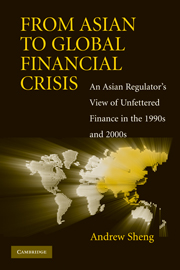 From Asian to Global Financial Crisis
From Asian to Global Financial Crisis Book contents
- Frontmatter
- Contents
- List of Figures
- List of Tables
- Acknowledgements
- Introduction
- 1 Things Fall Apart
- 2 Japan and the Asian Crisis
- 3 The Beam in Our Eyes
- 4 Banking: The Weakest Link
- 5 Washington Consensus and the IMF
- 6 Thailand: The Karma of Globalization
- 7 South Korea: Strong Body, Weak Heart
- 8 Malaysia: The Country That Went Its Own Way
- 9 Indonesia: From Economic to Political Crisis
- 10 Hong Kong: Unusual Times Need Unusual Action
- 11 China: Rise of the Dragon
- 12 From Crisis to Integration
- 13 The New World of Financial Engineering
- 14 What's Wrong with Financial Regulation?
- 15 The Global Financial Meltdown
- 16 A Crisis of Governance
- From Asian to Global Crisis: Chronology of Notable Events
- Abbreviations and Acronyms
- Bibliography
- Index
13 - The New World of Financial Engineering
Published online by Cambridge University Press: 05 June 2012
- Frontmatter
- Contents
- List of Figures
- List of Tables
- Acknowledgements
- Introduction
- 1 Things Fall Apart
- 2 Japan and the Asian Crisis
- 3 The Beam in Our Eyes
- 4 Banking: The Weakest Link
- 5 Washington Consensus and the IMF
- 6 Thailand: The Karma of Globalization
- 7 South Korea: Strong Body, Weak Heart
- 8 Malaysia: The Country That Went Its Own Way
- 9 Indonesia: From Economic to Political Crisis
- 10 Hong Kong: Unusual Times Need Unusual Action
- 11 China: Rise of the Dragon
- 12 From Crisis to Integration
- 13 The New World of Financial Engineering
- 14 What's Wrong with Financial Regulation?
- 15 The Global Financial Meltdown
- 16 A Crisis of Governance
- From Asian to Global Crisis: Chronology of Notable Events
- Abbreviations and Acronyms
- Bibliography
- Index
Summary
Derivatives are financial weapons of mass destruction, carrying dangers that, while now latent, are potentially lethal.
We view them as time bombs, both for the parties that deal in them and the economic system.
~ Warren BuffettAlthough the benefits and costs of derivatives remain the subject of spirited debate, the performance of the economy and the financial system in recent years suggests that those benefits have materially exceeded the costs.
~ Alan GreenspanNow that we have completed an overview of how the Asian crisis evolved and the individual country stories, we are ready to review how that crisis created the conditions for the present global financial crisis.
History is a river of memory that runs from many streams, sometimes calm and other times cataclysmic. Like a decision tree chart, events fan out from turning points in history, setting the conditions for the next event. The factors that led to the Asian crisis were also the key reasons for the current crisis: globalization, technology, financial innovation and deregulation, but the last two factors were critical in the latter crisis. The build-up of leverage and globalization of trade and financial services could not have happened without financial innovation in new institutions and derivative products that changed the financial landscape. All these became possible because of financial deregulation.
In hindsight, we could see signs of the present crisis emanating from the Asian crisis. The lethal brew of large capital flows, high market volatility, leverage and investment banks were all there during the Asian crisis.
- Type
- Chapter
- Information
- From Asian to Global Financial CrisisAn Asian Regulator's View of Unfettered Finance in the 1990s and 2000s, pp. 325 - 349Publisher: Cambridge University PressPrint publication year: 2009


